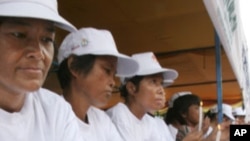It took more than decade for HIV/AIDS to reach Cambodia after the lethal viral illness saw its first documented case in the United States in1981.
But in the 21 years since, Cambodia has made strides in reducing the prevalence of the disease—far below 1 percent.
Cambodian health officials will travel to Washington in July to share their experiences and ideas at the 19th International AIDS Conference. Health officials now say they are worried a decrease in aid funding to fight the disease could hurt their efforts to stop it.
“After checking the annual rate of HIV patients, we could see a big decrease in the HIV rate,” Mean Chivun, director of the Center Against HIV, Skin Disease, and Venereal Disease at the Ministry of Health, told VOA Khmer. “In 1998 there were 100 new HIV patients a day. From 2010 to 2012, that daily rate is approximately 2.”
By 2010, 63,000 of the 14 million people living in Cambodia, or about 0.5 percent of the population, were sick with HIV/AIDS, according to government figures.
However, recent budget cuts due to the global economic crisis have required a reevaluation of funding, redirecting the flow of money towards countries that have yet to see substantive improvement.
That means some funding to Cambodia has been cut.
Cambodia’s HIV/AIDS rate improvement relies on about $50 million per year for treatment, supplies, and preventative measures; 90 percent of this comes from external donations, largely from the US Agency for International Development and the Global Fund for AIDS, Tuberculosis, and Malaria.
Both of these aid agencies have faced particular fiscal hardship in recent years.
The Global Fund, for example, eliminated its eleventh round of funding altogether this past spring and will provide no new grants until 2014.
The shockwaves of these changes have hardest hit the 170 non-profit groups in Cambodia to whom the Cambodian government channels external funding. Of these groups, the Khmer HIV/AIDS NGO Alliance, or Khana, receives the majority of the funds, more than 50 percent.
Khana’s director, Um Sopheap, acknowledges the pitfalls of these budget cuts, but remains optimistic.
“The sponsoring countries cut off aid to Cambodia because Cambodia already succeeded in HIV prevention,” he told VOA Khmer. “The Global Fund and the US government also have their own [economic] problems, so the funding was decreased. [But] the HIV rate [in Cambodia] will be lower in the next several years.”
This is because the US recently pledged to provide further aid from October 2012 until September 2017, he said.
The Cambodian government shares this optimism. In a recent national plan, health officials outlined a plan to cut the annual rate of new HIV infections to zero by 2020, citing recent trends as the basis for their prediction.
The Health Ministry’s Mean Chivun attributes the decrease to a changing mindset among sexually active Cambodians, claiming that on whole, infected individuals are now actively committed to not spreading HIV to their partners.
However, several groups are still at risk: men who have sex with men, homosexuals, nightclub workers, especially beer promotion girls, and drug users.
A female patient, who requested anonymity, said that most Cambodian women are “shy to discuss the problems [of HIV and AIDS]” with their husbands. Because of this, she said, she contracted HIV in 2002 from her husband.




